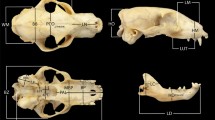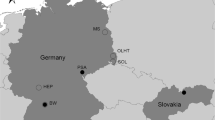Abstract
Hezhengia bohlini is one of the extinct bovids with the most abundant material, especially skulls. To date, skulls have been described, and the phylogenetic relationships and dietary habits have been discussed, but the ontogenetic processes of this special bovid with robust horn cores and a heavily built cranium have not yet been explored. Intraspecific variation in H. bohlini is high, but the variation ranges of different parts of the skull are unknown. In this study, we took 28 measurements and distinguished five age stages from sub-adult to senile. We described the ontogeny of the horn core, dentition, and skull and compared allometric growth and intraspecific variations of different parts of the skull. Although horn core growth and cranial roof arching are supposed highly related, horn core robustness is not related to cranium shape, basioccipital size, nor skull length or width. The rapid horn core growth of H. bohlini occurs in a very short period, from sub-adult to adult, whereas minor modifications and the deposition of exostoses are lifelong processes. The ontogenetic trajectory of H. bohlini differs from that of the closely related urmiatherine, Urmiatherium intermedium, in its late horn core development and cranial roof elevation, but characteristic features of basicranium development are only slightly different in both species. This study not only provides a good model for the study of ontogenetic and intraspecific variations in fossil bovids but also provides a framework for classifying other bovids known from fewer materials.








Similar content being viewed by others
Data Availability
All materials are preserved in Hezheng Paleozoological Museum, Gansu, China, and the Institute of Vertebrate Paleontology and Paleoanthropology, Chinese Academy of Sciences, Beijing, China. They are available at any time.
References
Allen JA. (1913) Ontogenetic and other variations in muskoxen, with a systematic review of the muskox group, recent and extinct. Mem Amer Mus Nat Hist 1: 101–226
Bärmann EV, Wronski T, Lerp H, Azanza B, Börner S, Erpenbeck D, Rössner GE, Wörheide G (2013) A morphometric and genetic framework for the genus Gazella de Blainville, 1816 (Ruminantia: Bovidae) with special focus on Arabian and Levantine mountain gazelles. Zool J Linn Soc 169: 673–696
Bohlin B (1935) Cavicornier der Hipparion-Fauna Nord-China. Palaeont Sin Ser C 9: 1–166
Bohlin B (1937) Einige Bemerkungen über die Hörner der Ovibovinae. Bull Geol Instit Upsala 27: 42–47
Bro-Jørgensen J (2012) Longevity in bovids is promoted by sociality, but reduced by sexual selection. Plos One 7: e45769
Castelló JR (2016) Bovids of the World: Antelopes, Gazelles, Cattle, Goats, Sheep, and Relatives. Princeton University Press. Oxford
Estes RD (1991) The significance of horns and other male secondary sexual characters in female bovids. Appl Anim Behav Sci 29: 403–451
Estes RD (2014) The Gnu’s World. University of California Press, London
Gomes Rodrigues H, Herrel A, Billet G (2017) Ontogenetic and life history trait changes associated with convergent ecological specializations in extinct ungulate mammals. Proc Natl Acad Sci USA 114: 1069–1074
Hillson S (2005) Teeth. Cambridge University Press. Cambridge
Jiang ZG (2004) Przewalski’s gazelle (in Chinese). China Forestry Publishing House, Beijing
Jafarzadeh R, Kostopoulos D, Daneshian J (2012) Skull reconstruction and ecology of Urmiatherium polaki (Bovidae, Mammalia) from the upper Miocene deposits of Maragheh, Iran. PalZ 86: 103–111
Jordana X, Marín-Moratalla N. Moncunill-Solé B, Bover P, Alcover JA, Köhler M (2013) First fossil evidence for the advance of replacement teeth coupled with life history evolution along an anagenetic mammalian lineage. PLos One 8: e70743
Lanzetti A (2019) Prenatal developmental sequence of the skull of minke whales and its implications for the evolution of mysticetes and the teeth-to-baleen transition. J Anat 235: 725–748
Lazaridis G, Kostopoulos DS, Lyras G, Roussiakis S (2017) A new Late Miocene ovibovine-like bovid (Bovidae, Mammalia) from the Kassandra Peninsula (Chalkidiki, Northern Greece) and implications to the phylogeography of the group. PalZ 91: 427–437
Lu X (2003) Postnatal growth of skull linear measurements of Cape Hare Lepus capensis in northern China: an analysis in an adaptive context. Biol J Linn Soc 78: 343–353
de Mecquenem R (1925) Contribution à l' étude des fossils de Maragha. Ann Paléontol 14: 1–36
Monson TA, Hlusko LJ (2018) The evolution of dental eruption sequence in artiodactyls. J Mammal Evol 25: 15–26
Morris P (1972) A review of mammalian age determination methods. Mammal Review 2: 69–104
Moyano SR, Cassini GH, Giannini NP (2019) Skull ontogeny of the hyraxes Procavia capensis and Dendrohyrax arboreus (Procaviidae: Hyracoidea). J Mammal Evol 26: 317–331
Nasif NL, Abdala F (2015) Craniodental ontogeny of the pacarana Dinomys branickii Peters 1873 (Rodentia, Hystricognathi, Caviomorpha, Dinomyidae). J Mammal 96: 1224–1244
Orlandi-Oliveras G, Nacarino-Meneses C, Köhler M (2019) Dental histology of late Miocene hipparionins compared with extant Equus, and its implications for Equidae life history. Palaeogeogr, Palaeoclimatol, Palaeoecol 528: 133–146
Pérez‐Barbería FJ (1994) Determination of age in Cantabrian chamois (Rupicapra pyrenaica parva) from jaw tooth‐row eruption and wear. J Zool Lond 233: 649–656
Qiu ZX, Wang BY, Xie GP (2000) Preliminary report on a new genus of Ovibovinae from Hezheng District, Gansu, China (in Chinese with English summary). Vertebr PalAsiat 38: 128–134
Robinette WL, Archer AL (1971) Notes on ageing criteria and reproduction of Thomson's gazelle. Afr J Ecol 9: 83–98
Rodler A (1889) Über Urmiatherium polaki n. g. n. sp., einen neuen Sivatheriiden aus dem Knochenfelde von Maragha. Denkschr Akad Wiss Math-Naturwiss Kl 56: 315–322
Semprebon GM, Solounias N, Deng T (2017) Dietary reconstruction of Hezhengia bohlini (Artiodactyla, Bovidae) from the late Miocene Basin of China using enamel microwear. Palaeogeogr, Palaeoclimatol, Palaeoecol 481: 57–63
Shi QQ, Wang SQ, Chen SK, Li YK (2016) The first discovery of Urmiatherium (Bovidae, Artiodactyla) from Liushu Formation, Linxia Basin. Vertebr PalAsiat 54: 319–331
Shi QQ, Deng T (2021) Redescription of the skull of Hezhengia bohlini (Artiodactyla, Mammalia) and a reassessment of the systematics of the Chinese late Miocene ‘ovibovines’. J Syst Palaeontol 18: 2059–2074
Smith BH (2000) ‘Schultz’s Rule’ and the evolution of tooth emergence and replacement patterns in primates and ungulates. In: Teaford MF, Smith MM, Ferguson MWJ (eds) Development, Function and Evolution of Teeth. Cambridge University Press, Cambridge
Tarnawski BA, Cassini GH, Flores DA (2014). Skull allometry and sexual dimorphism in the ontogeny of the southern elephant seal (Mirounga leonina). Can J Zool 92: 19–31
Tavares WC, Pessôa LM, Seuánez HN (2019) Changes in ontogenetic allometry and their role in the emergence of cranial morphology in fossorial spiny rats (Echimyidae, Hystricomorpha, Rodentia). J Mammal Evol 26: 575–585
Veitschegger K, Sánchez-Villagra MR (2016) Tooth eruption sequences in cervids and the effect of morphology, life history, and phylogeny. J Mammal Evol 23: 251–263
Weston EM (2003) Evolution of ontogeny in the hippopotamus skull: using allometry to dissect developmental change. Biol J Linn Soc 80: 625–638
Acknowledgements
We thank Zhan-Xiang Qiu (IVPP) for his helpful discussions and modifications of the manuscript, Michael Benton (University of Bristol) for his advice in the research, Jan-Ove R. Ebbestad and Benjamin R. Kear for access to the fossil bovid collection in the Museum of Evolution in Uppsala University, Wen He and Shan-Qin Chen for access to the fossil bovids in Hezheng Paleozoological Museum, Jin Chen and Dong-Sheng Li for access to the fossil and extant bovid collections in the Institute of Vertebrate Paleontology and Paleoanthropology. We thank the field team for their help in the fieldwork. We gratefully acknowledge the editors and two anonymous reviewers for their helpful comments and suggestions. This work was supported by Chinese Academy of Sciences (QYZDY-SSW-DQC002, XDB26000000, XDA20070203, XDB31030106, GJHZ1885), National Natural Science Foundation of China (41402020, 41872005), the Royal Society and the Newton Fund (NA160290).
Funding
Chinese Academy of Sciences (QYZDY-SSW-DQC002, XDB26000000, XDA20070203, XDB31030106, GJHZ1885). National Natural Science Foundation of China (41402020, 41872005), the Royal Society and the Newton Fund (NA160290).
Author information
Authors and Affiliations
Corresponding author
Supplementary Information
Below is the link to the electronic supplementary material.
Rights and permissions
About this article
Cite this article
Shi, QQ., Hou, SK., Sun, BY. et al. Ontogenetic and Intraspecific Variation in the Skull Morphology of the Late Miocene Bovid Hezhengia bohlini. J Mammal Evol 28, 871–884 (2021). https://doi.org/10.1007/s10914-021-09558-5
Accepted:
Published:
Issue Date:
DOI: https://doi.org/10.1007/s10914-021-09558-5




